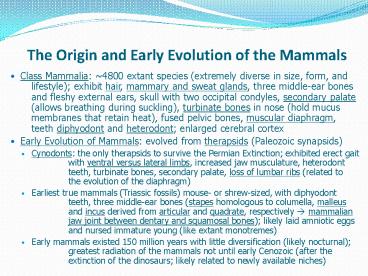The Origin and Early Evolution of the Mammals
1 / 20
Title:
The Origin and Early Evolution of the Mammals
Description:
The Origin and Early Evolution of the Mammals Class Mammalia: ~4800 extant species (extremely diverse in size, form, and lifestyle); exhibit hair, mammary and sweat ... –
Number of Views:4339
Avg rating:3.0/5.0
Title: The Origin and Early Evolution of the Mammals
1
The Origin and Early Evolution of the Mammals
- Class Mammalia 4800 extant species (extremely
diverse in size, form, and lifestyle) exhibit
hair, mammary and sweat glands, three middle-ear
bones and fleshy external ears, skull with two
occipital condyles, secondary palate (allows
breathing during suckling), turbinate bones in
nose (hold mucus membranes that retain heat),
fused pelvic bones, muscular diaphragm, teeth
diphyodont and heterodont enlarged cerebral
cortex - Early Evolution of Mammals evolved from
therapsids (Paleozoic synapsids) - Cynodonts the only therapsids to survive the
Permian Extinction exhibited erect gait with
ventral versus lateral limbs, increased jaw
musculature, heterodont teeth, turbinate bones,
secondary palate, loss of lumbar ribs (related to
the evolution of the diaphragm) - Earliest true mammals (Triassic fossils) mouse-
or shrew-sized, with diphyodont teeth, three
middle-ear bones (stapes homologous to columella,
malleus and incus derived from articular and
quadrate, respectively ? mammalian jaw joint
between dentary and squamosal bones) likely laid
amniotic eggs and nursed immature young (like
extant monotremes) - Early mammals existed 150 million years with
little diversification (likely nocturnal)
greatest radiation of the mammals not until
early Cenozoic (after the extinction of the
dinosaurs likely related to newly available
niches)
2
Fig. 28.2
3
Fig. 28.3
4
Fig. 28.4 and Fig. 28.5
5
Class Mammalia Diversity and Taxonomy
- Subclass Prototheria, Order Monotremata
(Monotremes) lay an amniotic egg, examples
include platypus (with electroreceptive bill and
venomous spine) and echidnas of Australia and
New Guinea - Subclass Theria
- Infraclass Metatheria (Marsupials) immature
young nursed in abdominal pouch (marsupium)
include American opossums, possums, koalas,
wombats, wallabies, kangaroos, and Tasmanian
devils (mostly Australian region) - Infraclass Eutheria (Placental Mammals) 18
orders (12 shown below)
Insectivora shrews, hedgehogs, moles 440 species Rodentia squirrels, woodchucks, rats, mice, beavers, porcupines 2052 species
Chiroptera bats 977 species Sirenia sea cows and manatees 4 species
Primates prosimians, monkeys, apes, humans 279 species Perrisodactyla odd-toed hoofs (horses, asses, zebras, tapirs, rhinos) 17 species
Xenarthra anteaters, armadillos, sloths 29 species Artiodactyla even-toed hoofs (swine, camels, deer, hippos, giraffes, cattle, sheep) 221 species
Proboscidea elephants 2 species Carnivora dogs, wolves, cats, bears, weasels, pinnipeds (seals and sea lions) 280 species
Lagomorpha rabbits, hares, pikas 81 species Cetacea whales, dolphins, porpoises 78 species
6
Fig. 28.41
7
Mammals Integument, Teeth, and Feeding
- Integument and Derivatives
- Hair composed of dead, keratin-packed epidermal
cells follicles of epidermal origin, but extend
into dermis underhair for insulation, guard
hairs protect against wear and provide
coloration of pelage (fur coat) hair
continuously replaced, but most mammals molt
entire coat periodically (summer coats often
brown, thin vs. white, thick winter coats)
vibrissae sensory hairs on snout (whiskers)
quills modified hairs for defense (ex.
porcupines) - Horns and Antlers true horns (keratin) with bony
core, not shed, grow continuously (ex. sheep and
cattle) antlers (deer family) branched and
composed of bone covered by soft skin (velvet),
shed after breeding season rhino horns not
attached to skull, composed of cemented filaments
of keratin - Glands sweat glands cool body (eccrine glands)
and signal reproductive stage (apocrine glands)
scent glands secrete pheromones used to attract
opposite sex and mark territories sebaceous
glands secrete sebum, which lubricates hair
mammary glands secrete milk via nipples (excl.
monotremes) - Teeth and Feeding heterodont teeth (incisors,
canines, premolars, molars) - Specializations insectivores herbivores
(grazers, gnawers) feed continuously, with long
digestive tracts and fermentation chambers
(endosymbiotic bacteria digest cellulose)
carnivores with shorter GI tract, piercing and
slicing teeth (incl. carnassial teeth)
omnivores include bears, pigs, raccoons,
primates rodents store food in caches rabbits
coprophagous - Metabolic rates decline with increasing body size
8
Fig. 28.6
9
Fig. 28.10
10
Fig. 28.11
11
Fig. 28.12
12
Fig. 28.15
13
Mammals Reproduction, Behavioral Ecology,
Populations, and Endangered Species
- Reproduction female fertility limited by estrous
cycles monotremes lay eggs in a burrow, young
drink milk after hatching marsupials with short
gestation, embryonic diapause, and development
of young in external pouch (marsupium)
placentals with long gestation, fecundity highly
variable (usually higher for small mammals) - Territory and Home Range territories (defended
home ranges) commonly marked by scents home
ranges typically foraging areas (can overlap)
social mammals include prairie dogs - Migration more rare than in birds and fishes
caribou winter in taiga, calve in tundra
cetaceans and pinnipeds with longest migrations
(ex. gray whales migrate between Alaska and
calving lagoons in Baja California) - Flight and Echolocation bats only true flying
mammals (gliding in some rodents and
marsupials) bats and toothed whales use
echolocation to find food and navigate bats
collect echoes with ears, toothed whales create
sound in sinuses, collect echoes with lower jaws
- Mammalian Populations and Endangered Species
small mammals often with highly fluctuating
populations top predators with naturally low
populations in 2006, 510 mammals listed as
endangered (imminent risk of extinction),
including most cetaceans (baiji recently
declared extinct), wild cats, and non-human
primates, plus many more considered threatened
(forseeable risk of extinction)
14
Fig. 28.22
15
Fig. 28.23
16
Fig. 28.25
17
Fig. 28.17
18
Fig. 28.18
19
Fig. 28.20
20
Fig. 28.28































